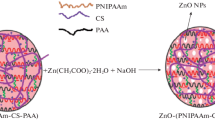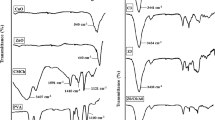Abstract
Nanostructured hydrogels obtained by the in situ sol-gel technology represent innovative systems for theranostic applications. Controlled self-assembly of charged macromolecular chains to form a polymer network due to specific non-covalent interactions is one of the methods to produce ionic biopolymer-based nanoscale gels. However, the structural lability and kinetic instability of such systems are significant disadvantages. In this study, we propose a preparation process of hybrid nanogels based on chitosan hydrochloride-ascorbate by biomimetic sol-gel synthesis at 20 and 80 °С using an organic-inorganic precursor. With the influence of the concentrations of the precursor, the binary chitosan salt, and a low-molecular-weight accelerator, the temperature of the sol-gel synthesis on the gelation time of our multicomponent chitosan-containing systems was evaluated. An increased concentration of the polymer salt, the introduction of an accelerator, and an increased temperature are shown to accelerate the gelation process. The refractive index (n D 25) and pH of the silicon-chitosan-containing hydrogels were measured. A solid phase in these hydrogels was isolated by cold extraction combined with cryotreatment. Scanning electron microscopy shows that the solid phase of the hybrid nanogels is a matrix of agglomerated particles whose sizes increase with the chitosan concentration in the system.


Similar content being viewed by others
References
Sahoo, A. K., Banerjee, S., Ghosh, S. S., Chattopadhyay, A. (2013). Simultaneous RGB emitting Au nanoclusters in chitosan nanoparticles for anticancer gene theranostics. ACS Applied Materials & Interfaces, 6, 712–724.
Rinaudo, M. (2006). Chitin and chitosan: properties and applications. Progress in Polymer Science, 31, 603–632.
Yhee, J. Y., Son, S., Kim, S. H., Park, K., Choi, K., Kwon, I. C. (2014). Self-assembled glycol chitosan nanoparticles for disease-specific theranostics. Journal of Controlled Release, 193, 202–213.
Tan, X. C., Tian, Y. X., Cai, P. X., Zou, X. Y. (2005). Glucose biosensor based on glucose oxidase immobilized in sol-gel chitosan/silica hybrid composite film on Prussian blue modified glass carbon electrode. Analytical and Bioanalytical Chemistry, 381, 500–507.
Wu, J., & Sailor, M. J. (2009). Chitosan hydrogel capped porous SiO2 as a pH responsive nano valve for triggered release of insulin. Advanced Functional Materials, 19, 733–741.
Alexander, A., Khan, J., Saraf, S. (2014). Formulation and evaluation of chitosan based long acting injectable hydrogel for PEGylated melphalan conjugate. Journal of Controlled Release , 66, 1240–1250.
Gordova, V. S., Sapozhnikov, S. P., Sergeeva, V. E., Karyshev, P. B. (2013). Basics of silicification. Bulletin of Chuvash University, 3, 401–409.
Sumper, M., & Brunner, E. (2008). Silica biomineralisation in diatoms: the model organism Thalassiosira pseudonana. ChemBioChem, 9, 1187–1194.
Mackenzie, J. D., & Bescher, E. P. (2007). Chemical routes in the synthesis of nanomaterials using the sol-gel process. Accounts of Chemical Research, 40, 810–818.
Spinde, K., Kammer, M., Freyer, K., Ehrlich, H., Vournakis, J. N., Brunner, E. (2011). Biomimetic silicification of fibrous chitin from diatoms. Chemistry of Materials, 23, 2973–2978.
Shchipunov, Y. A., & Karpenko, T. Y. Y. (2004). Hybrid polysaccharide-silica nanocomposites prepared by the sol-gel technique. Langmuir, 20, 3882–3887.
Shchipunov, Y. A., Karpenko, T. Y. Y., Krekoten, A. V. (2005). Hybrid organic-inorganic nanocomposites fabricated with a novel biocompatible precursor using sol-gel processing. Composite Interfaces, 11, 587–607.
Larchenko, E. Y., Khonina, T. G., Shadrina, E. V., Pestov, A. V., Chupakhin, O. N., Menshutina, N. V., et al. (2014). Pharmacologically active hydrogels derived from silicon glycerolates and chitosan. Russian Chemical Bulletin, 63, 1225–1231.
Larchenko, E. Y., Shadrina, E. V., Khonina, T. G., Chupakhin, O. N. (2014). New hybrid chitosan-silicone-containing glycerohydrogels. Mendeleev Communications, 24, 201–202.
Zudina, I.V., Fomina, V.I., Shipovskaya, A.B. (2014) Gel composition of a wide spectrum of biological action. RF Pat № 2535141.
Khonina, T. G., Chupakhin, O. N., Larionov, L. P., Sorokin, P. V., Zabokritski, N. A., Suvorov, A. L., et al. (2009). Synthesis and biological activity of organosilicontitanium glycerohydrogels. Pharmaceutical Chemistry Journal, 43, 95–100.
Larchenko, E.Y. (2015) Dimethylsilyl esters of glycerol and its derivatives. Synthesis and Properties. Dissertation, Postovsky Institute of Organic Synthesis, Russian Academy of Sciences.
Acknowledgments
The authors thank TG Khonina and EV Shadrina (Postovsky Institute of Organic Synthesis, Yekaterinburg, Russian Academy of Sciences) for their help in mastering the silicon glycerolate synthesis technique.
Author information
Authors and Affiliations
Corresponding author
Ethics declarations
Conflict of Interest
The authors declare that they have no competing interests.
Rights and permissions
About this article
Cite this article
Malinkina, O.N., Sobolev, A.M. & Shipovskaya, A.B. Hybrid Nanogels Based on Chitosan Hydrochloride-Ascorbate Derived by Sol-Gel Biomimetic Synthesis. BioNanoSci. 6, 157–161 (2016). https://doi.org/10.1007/s12668-016-0195-z
Published:
Issue Date:
DOI: https://doi.org/10.1007/s12668-016-0195-z




